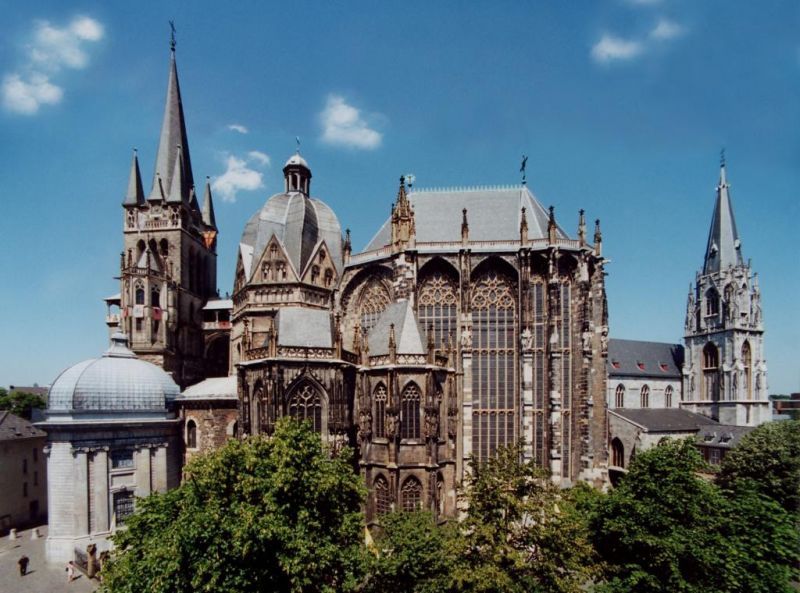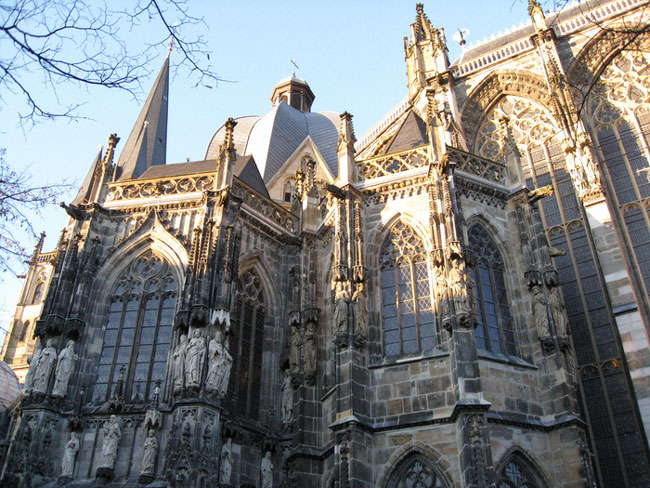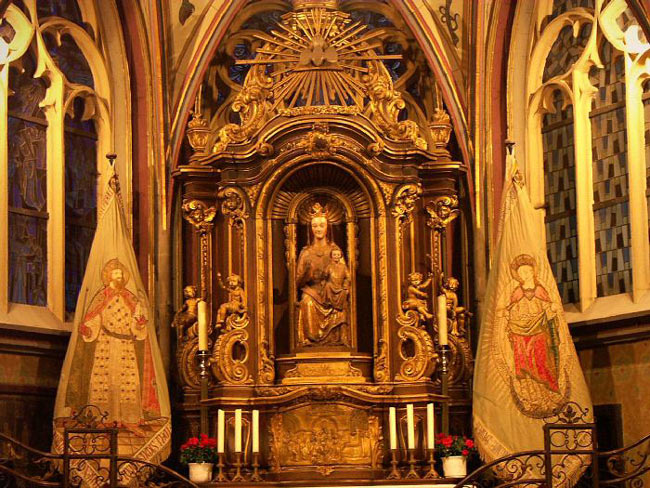Aachen Cathedral - Germany
Aachen cathedral - World cultural heritage in Germany
Aachen cathedral is a Catholic church in the city of Aachen, western Germany. This is the oldest cathedral in Northern Europe. Karl Dai built the Aachen Cathedral from 785 and it was completed in 800, after 15 years of construction. From the time when he was built, the abbot of Reichenau Monastery, Walahfrid Strabo, praised Karl Dai's prayer house as "the great temple of Solomon" .

Placement of the 2-storey dome-shaped tall octagonal building follows the Byzantine Church of San Vitalc in Italy's Ravenna, the reign of the emperors of the Western Roman Empire.
The columns in the upper stairway originated in ancient times, of which 6 red porphyry stone columns from Egypt, the stone used only for the emperor at the time.

Until 1531, 30 German emperors were seated on the throne to receive the Holy Roman Empire of the German peoples of Emperor Karl . The most precious objects in the Aachen cathedral, which today are admired, are objects donated by the German emperors. Later emperors wanted to follow Karl the Emperor and inherit the Roman Empire's media. Among those treasures with a giant hanging ball donated by Emperor Friedrich Bar-barossa (1122-1190) can be said to be not only extremely valuable but also extremely sophisticated.
Aachen Cathedral is also known as St. Maria's Royal Cathedral of Aachen . In nearly 600 years from 936 to 1531, this place took place the ceremony for 30 kings and 12 German queens. This church has a bishop's throne from 1802 to 1825, then the operation of this church was interrupted for a while until 1930 the diocese was re-established here.

If the outside architecture has overwhelmed the viewers, the architecture inside the church must surprise everyone and it feels like being lost in an art museum with countless pictures and exquisite carvings. .
The core of the cathedral of Aachen is a royal chapel. Initially Karl the Great built this place just to serve the royal family. Later, in the opinion of Pope Leo III, this place was extended to honor St. Mary . In the following, the architecture continued to expand and construction work only really ended after 15 years. With the magnificence and perfect architecture, the project was recognized as a World Heritage Site by Unesco, it is worth mentioning that this is the first German project recognized by Unesco as one of the first three historical works. recognized in Europe.

Among the countless treasures stored at Aachen Cathedral, in addition to the above mentioned treasures, it is necessary to mention the great works of the church about the post-classical era, the Carolingian, Ottonian and Staufian periods such as Lothair Cross; Emperor Charlenagne's bust . The remains of Charlenagne are still buried in this cathedral.
In 1000, Emperor Otto III of the Roman Empire gave the tomb of Charlenagne. One of Emperor Otto's most close courtiers recorded the event in the Chronicle of Novalesia written in 1026 as follows: "So we went to the crypt of Charles. He was not lying, like the dead. another, sitting as if he was still alive, his head covered with a golden crown, hands with gloves, holding a scepter, fingernails through a glove that protruded out, above him with a sheet of limestone and When I came in, there was an odor that was hard to smell, we knelt down respectfully to the Emperor Charles and repaired the damaged things, the emperor's body was intact and only lost its nose. Replace that nose cap with gold, take one of Charles's teeth, build a wall to block the crypt entrance, then withdraw ".
A large picture depicting Emperor Otto and an admiring look at the emperor Charlemagne is painted on the hall wall of Aachen City Hall.
In 1165, Emperor Frederick Barbarossa continued to open this crypt and put the Emperor Charlenagne's body into a marble-made sarcophagus (a gem used for the great Caesar emperor of the Roman Empire). In 1215. Emperor Frederick II made a coffin of gold and silver and put Charlenagne's body in it.

Mary's relic of the relic is placed in the basilica from around 1220-1239. The exterior is decorated with sculptures of Christ, Mary, Emperor Charlenagne, Pope Leo III and 12 apostles. This holy relic contains four great relics of Aachen: the Cloak of Our Lady; The cloth of Christ; God's bloody loincloth on the Cross and the cloth wrapped around the lord's belt.
According to traditional customs from 1349, every 7 years the above saints are removed from the ark to display during the Great pilgrimage of Aachen .

Aachen cathedral is recognized by Unesco according to criteria (i), (ii), (vi)
Criterion (i): Italian and Greek marble columns and large paintings and the dome of Aachen Cathedral are masterpieces of stone art.
Criterion (ii): Renaissance and Byzantine architectural style , Aachen Cathedral is one of the typical architectural works of religious architecture in Europe.
Criterion (vi): Aachen cathedral is not only a high-value architectural works of art and history but also a place to store priceless religious treasures .






- Unique Germany with a view from above
- Wurzburg - Germany
- Intelligent vehicles for people with disabilities
- The scene inside Notre Dame Cathedral after the fire
- 4 the opposite in Germany but few people know
- Great Cathedral of St Peter
- Chartres Cathedral
- The largest churches in the world
- St Paul's Cathedral
- Drought in Spain in the past 500 years
- Notre Dame Cathedral in Tournai
- 16 weird facts about Germany
 Suzhou classic bonsai garden - China
Suzhou classic bonsai garden - China Chau Nguyen Dynasty
Chau Nguyen Dynasty Thai Son Mountain - World Wonder
Thai Son Mountain - World Wonder Ancient villages of Shirakawa-go and Gokayama
Ancient villages of Shirakawa-go and Gokayama